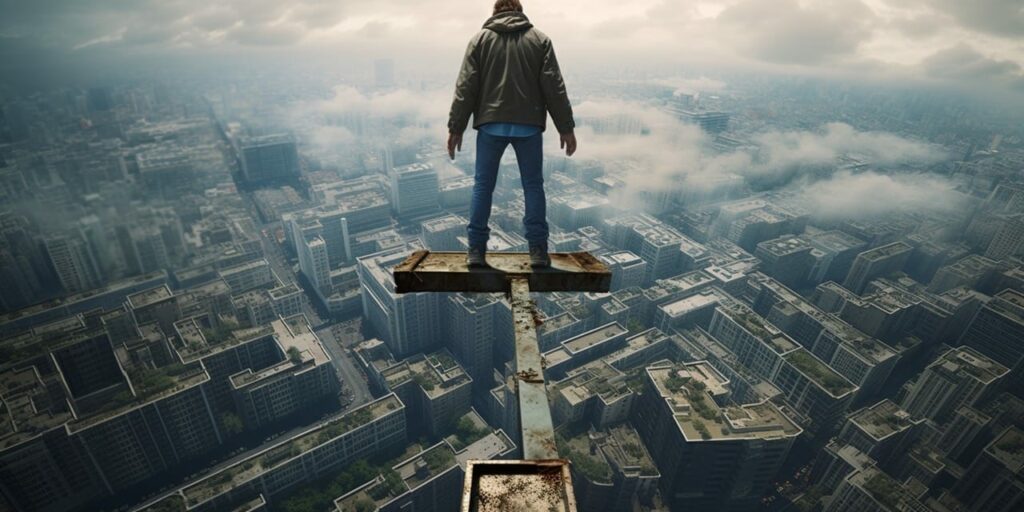I’ve always found it intriguing how fear of heights, or acrophobia, can grip so many of us. It’s not the height itself that sparks anxiety; it’s the thought of falling from that height. Acrophobia can happen to any one of us, yet it varies greatly in severity. Some may just feel a slight unease standing at the edge of a cliff, while others break into cold sweats at merely the thought.
It’s important to remember that fear is an ingrained survival mechanism – it’s there to protect us from danger. But when this fear becomes so intense and irrational that it hinders daily life activities, then we’re dealing with a phobia. The mere sight of tall buildings or mountains can make an acrophobic person feel dizzy and nauseous.
To put things in perspective, around 3-5% people globally suffer from acrophobia to varying degrees. That’s quite a substantial number! But remember, there’s good news too – like most fears and phobias, you’re not stuck with your fear of heights forever. With the right help and approach, overcoming this anxiety is completely attainable.
Understanding the Fear of Heights
I’m sure we’ve all felt it at some point. That stomach-dropping sensation when you look down from a high spot. Maybe it’s a tall building, a cliff edge, or even just the top of a staircase. This is acrophobia, better known as the fear of heights.
Acrophobia isn’t simply an irrational fear; it has roots deep within our evolutionary history. Back in our primitive days, falling from great heights was a real danger that could lead to serious injury or death. So naturally, humans developed a healthy respect for high places – and sometimes this respect can tip over into fear.
According to one study conducted by The National Institute of Mental Health (NIMH), around 5% of the general population experiences symptoms associated with acrophobia. Let’s put that in perspective:
| Population | Percentage |
|---|---|
| General Population | 100% |
| Affected by Acrophobia | 5% |
This doesn’t mean that everyone who feels uncomfortable on top of a skyscraper has acrophobia. It’s normal to feel some level of apprehension in high places where there’s an actual risk involved. But for those with true acrophobia, this discomfort can be triggered even in safe circumstances – like being on an escalator or crossing a bridge.
So what exactly happens when someone with acrophobia faces their fear? Well:
- They might experience dizziness or nausea
- Their heart rate may increase
- They could start sweating excessively
- Sometimes they might even have full-blown panic attacks
Now, let’s delve deeper into why some people develop this phobia while others don’t…
Psychological Aspects Behind Acrophobia
I’ve always found it fascinating how our minds can create such strong, visceral responses to certain situations. Take acrophobia, for example – the fear of heights. It’s not just a mild discomfort; it’s an intense, sometimes debilitating fear that can make even the thought of standing on a balcony or climbing a ladder feel like a life-threatening endeavor.
So what’s happening inside our heads when we experience this type of phobia? Psychologists suggest that at its core, acrophobia is connected to our instinctual drive for self-preservation. It’s an evolutionary response designed to keep us safe from potentially dangerous falls.
Let me share some statistics with you:
| % | Group |
|---|---|
| 28% | Adults who have reported experiencing acrophobia at some point in their lives |
| 5% | People who suffer from severe symptoms |
These numbers highlight just how common this fear is.
Evolutionary theories aside, there are also cognitive and behavioral aspects at play here. Cognitive psychology points out that those with acrophobia often overestimate vertical distances, which exacerbates their fear. They might look down from a third-floor window and perceive it as being much higher than it actually is.
In terms of behavior, avoidance plays a big part in maintaining the phobia. The more you avoid heights, the stronger the fear becomes because you’re reinforcing the idea that heights are dangerous and should be avoided at all costs.
Then there’s anxiety sensitivity – individuals suffering from acrophobia may have an increased sensitivity to physical sensations associated with anxiety (like dizziness or shortness of breath), which makes the experience of being high up even more distressing.
And finally, let’s not forget about traumatic experiences. For some people, their acrophobia might stem from a past incident involving heights – perhaps they had a bad fall when they were younger, or they witnessed someone else fall.
In short, there’s a lot going on behind the scenes of acrophobia. It’s not just “being scared of heights” – it’s a complex interplay of evolutionary instinct, cognitive distortions, learned behavior, and personal experience.
Common Symptoms of Height Phobia
So you’re wondering what the typical symptoms are for those dealing with a fear of heights? It’s not as straightforward as it might seem. People experience this phobia in different ways, but there are some common signs that can help identify it.
One of the most noticeable symptoms is an intense feeling of fear or dread when confronted with heights. This isn’t just a slight unease—it’s a powerful reaction that can make someone go to great lengths to avoid high places. Sweaty palms, rapid heartbeat, and shortness of breath are all physical manifestations of this fear.
Some folks might even feel dizzy or lightheaded when they’re up high. This sensation, often referred to as vertigo, isn’t simply being afraid—it’s a physical disorder that makes it feel like you or your surroundings are spinning. For people with height phobia, vertigo can be triggered by looking down from a high place.
Another symptom commonly seen is avoidance behavior. That means going out of one’s way to steer clear of situations involving heights. If you find yourself taking the stairs instead of the elevator at work, or turning down opportunities because they involve being up high—that could be indicative of height phobia.
Finally, panic attacks are another telltale sign. These episodes involve sudden feelings of terror that strike without warning and include symptoms such as sweating, shaking, chest pain and fearing loss of control or death.
Keep in mind these symptoms aren’t exhaustive—everyone experiences their fears differently—but if you’ve noticed several on this list in your reactions to heights, it could be time to consider getting professional help.
How Fear of Heights Affects Daily Life
Living with acrophobia, or fear of heights, isn’t just about sweaty palms when you’re up high. It’s an issue that can infiltrate daily life in ways most wouldn’t consider. From the apartments we choose to live in to the jobs we take, fear of heights can impose significant restrictions.
Take for example a simple task like apartment hunting. While many might be excited at the prospect of a penthouse view, those with a fear of heights would find it utterly terrifying. They’d be more likely to opt for lower floors which could limit their choices especially in big cities where high-rise buildings are common.
A job opportunity could also present challenges for someone living with this phobia. Careers like construction work, window cleaning or even being a flight attendant could potentially be off the table due to the height-related aspects involved.
Social activities aren’t exempt from its effects either. Think of amusement parks and rides – they’re no fun if you’re petrified by roller coasters or Ferris wheels that tower overheads. Even hiking trips and sightseeing tours involving tall landmarks can become daunting tasks instead of enjoyable outings.
Lastly, let’s not forget everyday chores around the house that require climbing up ladders or steps – changing lightbulbs or fetching items from top shelves can become nerve-wracking experiences rather than mundane tasks.
In conclusion:
- Apartment-hunting and job opportunities are limited due to choosing lower floors and avoiding height-related careers.
- Social activities like amusement parks, hiking trips and sightseeing tours involving tall landmarks become daunting.
- Everyday chores requiring ladder-climbing turn into nerve-wracking experiences instead of mundane tasks.
Living with a fear of heights is indeed challenging but understanding these impacts is the first step towards managing it effectively—and maybe even overcoming it completely one day!
Exploring the Causes of Acrophobia
Diving headfirst into acrophobia, it’s crucial to understand that this fear of heights isn’t a one-size-fits-all issue. Various factors contribute to its development, and each person might have a unique story behind their phobia.
Genetics play an integral role in shaping our fears and phobias. If your parents or siblings suffer from acrophobia, there’s a chance you could too. Research suggests there may be an inherited component linked with specific fears like acrophobia.
| Family Member | Percentage Chance of Acquiring Acrophobia |
|---|---|
| Parent | 10-20% |
| Sibling | 15-25% |
Past traumatic experiences also significantly contribute to the onset of this phobia. Let’s say you had an unfortunate fall from a high place as a kid; this event could trigger acrophobia later in life.
Furthermore, our natural survival instincts can exaggerate this fear. We’re hardwired to avoid danger and stay safe—heights inherently pose risks such as falling or getting injured.
- Trauma
- Genetics
- Survival instinct
Lastly, I’d like to point out how certain psychological conditions like anxiety disorders can worsen the fear of heights. For someone already dealing with severe anxiety, being at great heights can amplify their symptoms tremendously.
Remember, understanding the root cause is often the first step towards overcoming any fear or phobia. But don’t let these revelations scare you; they’re meant to help navigate through the journey of conquering your fears!
Effective Treatment Options for Height Phobia
Do you know that aversion to heights, also known as acrophobia, is a fairly common phobia? It’s estimated that about 3-5% of the general population experiences this fear. But here’s the good news – there are several proven treatments available to help overcome it.
Let’s start with Exposure Therapy. Primarily used in Cognitive Behavioral Therapy (CBT), it involves gradually and repeatedly exposing individuals to their fear until they become desensitized. For instance, someone might first imagine standing on a high balcony before actually doing so in a controlled setting.
Another effective method is Virtual Reality Exposure Therapy (VRET). This approach uses computer technology to create simulated environments that mimic real-life situations related to height. Research shows that after VRET treatment, around 83% of participants showed significant improvements in dealing with their height phobia.
Eye Movement Desensitization and Reprocessing (EMDR) is yet another technique often utilized for treating phobias like acrophobia. In EMDR, individuals recall traumatic memories while making specific eye movements guided by a therapist—this process helps alleviate anxiety symptoms linked to these memories.
Lastly, medication can be prescribed in severe cases where other therapies haven’t been effective enough. Beta-blockers and sedatives are typically used short-term during particularly stressful situations involving heights.
Here is a quick overview table summarizing these treatments:
| Treatment Method | Description |
|---|---|
| Exposure Therapy | Gradual exposure to feared object/situation |
| Virtual Reality Exposure Therapy (VRET) | Use of virtual reality simulations |
| Eye Movement Desensitization and Reprocessing (EMDR) | Combining memory recall with guided eye movements |
| Medication | Short-term use when other methods aren’t sufficient |
Remember, everyone’s journey towards overcoming their phobias is unique—what works for one person might not work for another. Therefore, it’s crucial to consult with a mental health professional who can guide you on the best treatment path that suits your individual needs.
Personal Stories: Living with the Fear of Heights
I’ve had a few run-ins with acrophobia, or fear of heights, in my lifetime. Once, on a family vacation to the Grand Canyon, I couldn’t even step close enough to the edge to see down into its majestic depths. My heart pounded like a drum and my legs felt like jelly – it was as if an invisible barrier kept me from experiencing one of nature’s most awe-inspiring wonders.
Fast forward a few years and I found myself facing my fear head-on during a rock climbing trip. Despite being securely harnessed, each move upwards echoed with an internal scream telling me how high up I was getting. Yet pushing through that paralyzing fear became one of my proudest moments.
It’s not just about physical reactions though. The mental toll acrophobia takes is equally challenging. Everyday scenarios can become nerve-racking experiences. Imagine feeling dizzy while looking over the railings at shopping malls or breaking out in cold sweat when taking an escalator up several floors!
Here are some stats that highlight this struggle:
| Statistic | Details |
|---|---|
| Number of people affected by acrophobia | 3-5% worldwide |
| Gender more prone to acrophobia | Women |
| Age group most affected by acrophobia | Adults aged 20-64 |
Living with this phobia isn’t all doom and gloom though! Many have found effective ways to manage their fear:
- Regular exposure therapy
- Mindfulness meditation
- Seeking professional help when needed
In many cases, understanding why we’re afraid is half the battle won. For instance, learning that our brains are wired for self-preservation – which sometimes translates into irrational fears like heights – helped me accept my own anxieties.
Every individual has their own unique way of coping with fears like these but remember – it’s okay if you’re not there yet. No one should feel pressured to overcome their fears on someone else’s timeline. Your journey is your own, and every step forward counts!
Conclusion: Overcoming Acrophobia
Overcoming the fear of heights, or acrophobia, isn’t an overnight process. It’s a journey that requires patience, determination and often professional help.
One common method used to conquer this fear is exposure therapy. This involves gradually exposing yourself to greater heights in controlled environments until your fear decreases. I’ve seen many people successfully utilize this technique in my time as a blogger on mental health topics.
Another approach is cognitive behavioral therapy (CBT). With CBT, you’ll work with a therapist to change your thought patterns related to heights, ultimately helping you react less fearfully when faced with them.
Let’s not forget about virtual reality (VR) treatments either! These are becoming more prevalent and have shown promise in treating various phobias including acrophobia. Through VR technology, you’ll be safely exposed to height-related scenarios which can help desensitize your reactions over time.
- Exposure Therapy: Gradual exposure to heights
- Cognitive Behavioral Therapy (CBT): Changing thought patterns
- Virtual Reality Treatments: Safe exposure through technology
We’re all different and what works for one might not work for another. So it’s important you try different methods and figure out what best suits your needs and comfort levels.
Remember that overcoming any fear takes time. Don’t rush the process but rather celebrate each small victory along the way. And most importantly? Never hesitate to seek professional support should you need it – there’s absolutely no shame in asking for help!
It’s been quite the journey exploring acrophobia together throughout this article series. Here’s hoping that this newfound knowledge will empower those affected by acrophobia and inspire them towards overcoming their fears.



